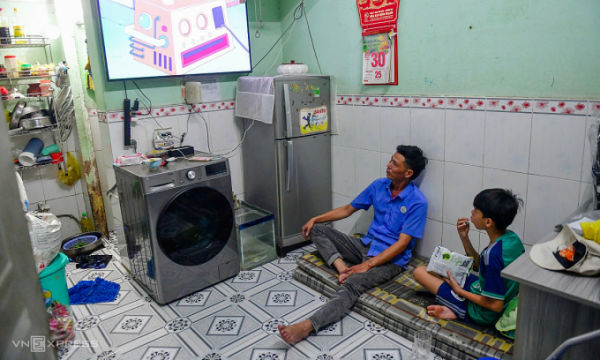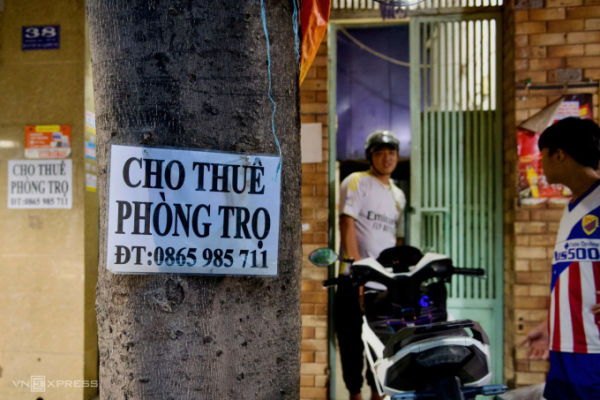
After enduring the Covid-19 pandemic in 2021, Le Van Thuong, a native of the north-central Thanh Hoa Province, once believed Ho Chi Minh City was his “destiny”.
In 2021, then 22, he had been working in event management in Hanoi for over a year when he decided to head south.
He had envisioned HCMC, the country’s economic hub, as a vibrant, open and opportunity-filled city ideal for young people like him.
He recalls: “The first shock was the pandemic. Lockdown hit before I could find a job.”
To earn enough for his daily expenses, he signed up for ride-hailing and delivery gigs throughout the lockdown.
After enduring three months of stringent social distancing rules, he convinced himself he could endure whatever came his way and be in the city for the long haul.
After Covid he secured a sales position at an event management company in 2022, earning around VND15 million (US$590) a month.
However, the economic downturn, budget cuts and dwindling client demand in the last two years meant he often relied solely on his base salary of just over VND5 million.
He notes how difficult it has been to save money in HCMC: “Rent, food and socializing eat up all my income, leaving nothing to save. Even meeting with a client costs me at least VND60,000 for a drink.”
Homeownership became an unreachable dream.
After nearly four years of grappling with the rising cost of living, the scales fell from Thuong’s eyes, and he let go of his “destiny”.
After considering his options, he decided to move to Hanoi where his friends had recommended a job with a 20% higher salary than in HCMC.
|
A man watches TV with his son in a rented room at a boarding house in Thu Duc City, HCMC, August 2024. Photo by Read/Thanh Tung |
His roommate, a designer from the southern Tra Vinh Province, also chose to leave HCMC after years of trying to settle in.
Like Thuong, hundreds of thousands of people from elsewhere have contributed to HCMC’s workforce over the past few decades, compensating for its low birth rate, the country’s lowest.
According to General Statistics Office data, in 2019 HCMC accounted for 11.5% of internal migrants, second only to Binh Duong Province (26.3%).
The International Organization for Migration reports that domestic migrant labor has been instrumental in developing export processing zones, industrial parks and urban areas, particularly in HCMC, for over two decades.
But these workers are now leaving or no longer considering the city an ideal destination.
Pham Chanh Trung, head of the city’s Population and Family Planning Department, says migration to the city has been declining for the last two years.
Last year, for the first time ever, the mechanical population growth rate (due to migration) dropped to 0.68%, lower than the natural growth rate (births minus deaths), which stood at 0.74%.
Between 2015 and 2021 the mechanical growth rate had consistently exceeded the natural rate, sometimes by a factor of two.
It typically saw an influx of around 170,000-180,000 migrants annually during those years.
But in 2023, with a 0.67% mechanical growth rate, migrant numbers dwindled to about 65,000.
In Binh Tan District, which has for long recorded the highest population growth in the city, the number of temporary residents has dropped in the last two years.
The district’s vice chairwoman, Le Thi Ngoc Dung, says that in 2020 the population was over 746,200, with 452,230 being temporary residents, meaning migrants.
By 2023 the latter number had fallen to 346,570, a decrease of almost 106,000.
Dung points out that Binh Tan is close to a number of industrial zones, and itself has the largest company in the city in terms of payroll (Taiwanese shoemaker Pou Yuen), and so attracts migrants.
But following a shortage of job opportunities and labor cuts, many workers have left.
 |
|
As many migrants have left HCMC for their hometowns, the owner of a boarding house Binh Tan District must hang an advertisement to look for new tenants, November 2024. Photo by Read/Thanh Tung |
Associate Professor Dr. Nguyen Duc Loc, Director of the Social Life Research Institute, said decades ago, HCMC was like a magnet with one of the strongest attractions in the country, offering infrastructure, jobs, income, opportunities, and favorable natural conditions.
However, in recent years, this magnetism has faced intense competition from other localities, some of which are even outperforming it. While the city’s pull has weakened, its push factors have intensified, such as high living costs, traffic congestion, reduced employment, and shrinking job opportunities.
The Provincial Governance and Public Administration Performance Index (PAPI) report revealed that in 2023, Ho Chi Minh City remained the most desired destination for people to move to, accounting for 21.68% of respondents. The main reason cited for wanting to move to the city was the hope of finding better job opportunities, representing 31.5% of responses—the highest percentage compared to the same criterion for the five other prioritized localities.
Experts noted that this indicates people from other provinces still think of or choose Ho Chi Minh City as a migration destination. However, their actual experiences in the city fall short of expectations, prompting them to leave. This trend has led to a sharp decline in the city’s net population growth during 2022–2023, suggesting that its push factors are increasing while its pull factors are gradually eroding.
In 2022 the Vietnam Chamber of Commerce and Industry and International Organization for Migration surveyed over 1,200 migrant workers in HCMC and its industrial hub neighbors, Dong Nai and Binh Duong provinces, and found 15.5% intended to return to their hometowns soon and 44.6% were undecided.
Only 39.9% had no plans to leave.
Most already had families and had left their children in their hometowns, hoping to earn higher incomes to cover living and education expenses back home.
Of those planning to return, 38% said their income in the city was insufficient to cover costs.
“HCMC’s appeal to migrants is diminishing,” Loc says. He warns that if the government does not respond, the trend will worsen, posing a big challenge to a city heavily dependent on migrant labor.
A study titled “Strategic Orientation for Employment and Skills Development in HCMC 2023-2025, Vision to 2030” done by the HCMC Institute for Development Studies found that its high cost of living hindered HCMC’s ability to attract migrant labor.
The city ranks among the localities with the highest price volatility in the country. Meanwhile, when average monthly income per capita is considered, the highest-earning group earns 3.5 times more than the lowest-earning group. Such disparities in wealth can easily lead to inequalities in access to social services, such as housing, employment, education, and healthcare.
Hoang Thi Minh Ngoc, operations director of Viec Lam Tot (Good Jobs), an employment portal, says job opportunities and income are the top factors drawing migrant workers, followed by living conditions, transportation, education, healthcare, labor management, and welfare policies.
According to a living wage study by the Anker Research Institute released late last year, a livable wage in cities like HCMC is around VND8.61 million per month.
But data compiled by the General Statistics Office data shows the city’s average income in 2023 was VND6.51 million (US$255), fourth highest after Binh Duong, Hanoi and Dong Nai.
“Lower-income groups such as manual workers are likely to leave first,” Ngoc says.
Migrant workers earning above this level may also leave if they cannot find career development or improved living conditions, especially as advances in technology and remote work enable more professionals to work from anywhere, she adds.